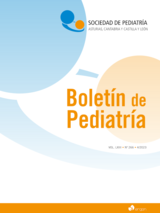Epidemiología de la enfermedad celíaca pediátrica en dos Áreas Sanitarias de Asturias
D. Pérez Solís , B. Montes Zapico , C. Molinos Norniella , C. Menéndez Arias , J.J. Díaz Martín
Bol. Pediatr. 2023; 63 (266): 261 - 267
Introducción y objetivos: En las últimas décadas se ha descrito un aumento de la incidencia de enfermedad celiaca (EC) y un predominio de formas de presentación menos sintomáticas. El objetivo de este estudio es describir las características clínicas de la EC en población pediátrica de dos áreas sanitarias de Asturias y estimar su incidencia. Pacientes y métodos: Estudio observacional, prospectivo y multicéntrico de pacientes de las áreas sanitarias III (Avilés) y V (Gijón) incluidos en el Registro Español de Pacientes Celíacos pediátricos REPAC2 (2011-2017). Se recogieron datos demográficos, síntomas, somatometría y pruebas diagnósticas. Se utilizaron criterios ESPGHAN 2020 para el estudio descriptivo y el cálculo de la incidencia, y criterios ESPGHAN 2012 para el análisis comparativo con el resto de España. Resultados: Se incluyen 99 casos (50,5% niñas): 72 del área V y 27 del área III. Mediana de edad: 3,1 años (P25-P75: 1,6-7,7). La forma de presentación más frecuente fue la EC clásica (76,8%), con un 2,0% de asintomáticos. Los síntomas más frecuentes fueron la pérdida/estancamiento de peso (55,7%) y la diarrea (49,5%). Respecto al resto de España (4681 casos), en Asturias (82 casos) se registró una menor frecuencia de asintomáticos (2,4% vs. 9,8%, p=0,026) y de realización de biopsias (28% vs. 62,1%, p<0,001). La tasa de incidencia de EC basada en diagnósticos hospitalarios fue de 32,1 (IC95%: 26,1-39,1) por 100 000 personas-año. Conclusiones: Se identifican diferencias geográficas en la presentación y diagnóstico de EC, y una mayor incidencia respecto a estudios previos.
Epidemiology of pediatric celiac disease in two Health Areas of Asturias (Spain)
Introduction and aims: Over the last few decades, it has been reported an increase in the incidence of celiac disease (CD) and a predominance of less symptomatic clinical presentations. This study aimed to describe the clinical characteristics of CD in the paediatric population of two health areas of Asturias and to estimate its incidence. Patients and methods: Observational, prospective, multicentre study of patients from health areas III (Avilés) and V (Gijón) included in the Spanish Registry of Paediatric Celiac Patients REPAC2 (2011-2017). Demographic data, symptoms, somatometry and diagnostic tests were collected. The incidence rate was calculated using the municipal register. ESPGHAN 2020 diagnostic criteria were used for the descriptive study and incidence calculation, and ESPGHAN 2012 criteria were used for the comparative analysis with the rest of Spain. Results: 99 patients (50.5% girls) were included: 72 from area V and 27 from area III. Median age: 3.1 years (P25-P75: 1.6-7.7). The most frequent clinical presentation was classic CD (76.8%), whereas 2.0% were asymptomatic. The most frequent symptoms were failure to thrive (55.7%) and diarrhoea (49.5%). Compared with the rest of Spain (4681 patients), Asturias (82 patients) had fewer asymptomatic patients (2.4% vs. 9.8%, p=0.026) and fewer biopsies performed (28% vs. 62.1%, p<0.001). The incidence rate of CD based on hospital diagnoses according to ESPGHAN 2020 criteria was 32.1 (95%CI: 26.1-39.1) per 100,000 person-years. Conclusions: Geographic differences were identified in the presentation and diagnosis of CD, with a higher incidence compared to previous studies.
Artículo completo (PDF) (121 kb.)
- Gastroenterología
